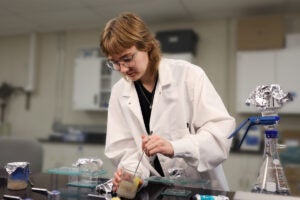AUSTIN, Texas —The conjugated polymer molecules used in Light Emitting Displays (LEDs) in computers funnel energy to single points, according to a research team at The University of Texas at Austin’s department of chemistry and biochemistry. Their research has been published in the Friday (Aug. 25) issue of the journal Science. Researchers said the discovery has potential uses in future polymer-based semiconductors.
Polymers are large organic molecules with extensive bonds between their atoms that have properties similar to those of semiconductors. Conjugated polymers have alternating single and
double bonds that enhance those electronic properties.
The UT Austin team includes Dr. Paul F. Barbara, the Richard J.V. Johnson-Welch Regents Chair in Chemistry; Dr. Dehong Hu, a postdoctoral fellow in the department of chemistry and biochemistry; and graduate student Ji Yu from the department of chemistry and biochemistry.
The researchers made their discovery using a technique called Single-molecule Spectroscopy (SMS) as well as a new technique for keeping the sample polymer molecules stable during SMS. SMS uses direct measurements of the way fluorescent light changes as it emerges from individual polymer molecules to determine the characteristics of those molecules.
The researchers found that a conjugated polymer funnels energy to a single point because of the way in which its molecules are folded. Barbara said the scientists were trying to determine “when you put energy into this molecule with light, does that energy just sort of jump all around the molecule, does it stay where you put it in the molecule, or does it collect like water in a funnel to one place in the molecule?
“Ji was able to prove in this paper that if you put energy into this — which we consider to be a huge molecule — all of the energy goes to a tiny little spot in the molecule.”
Barbara said that funneling might be undesirable commercially because wear would occur more quickly in a device such as an LED in which energy is not evenly distributed. He added that
creating the conjugated polymer in a more crumpled, versus regularly folded, structure might remedy this problem.
The research was funded by the National Science Foundation and the Welch Foundation.
Barbara, Dehong and Ji are members of another research team that discovered that the conjugated polymer — which is roughly 100,000 times larger than a water molecule — is regularly packed in folds. This discovery, reported the June 29 issue of the British journal Nature, was made using computer modeling and SMS.
For more information, contact Dr. Paul F. Barbara at (512) 471-2053 or e-mail: P.barbara@mail.utexas.edu For more information on the previous discovery, see the UT Austin Office of Public Affairs archives for June 28 at www.utexas.edu/admin/opa/news/nrarchive_indexes/00indexes/nr_june00.html



